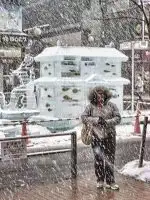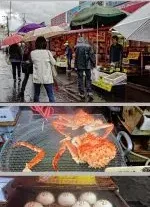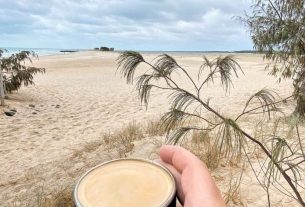
Fish and produce markets in Japan are exceptional for their quality, freshness and variety. These are our top picks from around the country, the must-try dishes from each and essential visitor tips.
We love a good market, especially a foodie market and Japan has some great hidden treasures for you to discover. They are a perfect place to immerse yourself in local life, observe the culture and have a great culinary experience at the same time. These food markets are part of the fabric of eating in Japan and many have been around for centuries. They preserve techniques, family brands and recipes that have been passed down through multiple generations.
An ichiba is a market or marketplace in Japan. I’m always on the lookout for new ones but these are all something special and well worth a visit during your stay in Japan. They aren’t targetted to the tourist but you can visit and taste many of the delicious products on-site and buy snacks to take away.
We’ve found so many of the shop owners incredibly welcoming and very open to sharing their story and a few tasters if you take the time to stop and work through the language barrier. These tiny shops that make up the markets are individually owned and they supply the local trade and families in the area providing an authentic culinary experience.
Street food, as we know it through most of Asia isn’t common in Japan. It’s considered quite rude in Japan to walk and eat. Instead the food and the person who prepared it should be respected by being present and aware while you enjoy the snack or meal. In line with this, you will find many of the small shops have a couple of tables and stools for you to sit and savour your purchase and some of the markets have a common area, sometimes associated with an information desk or management office that has tables for the same purpose.
Discovering the local cuisine, food preparation techniques and produce is a part of travelling that we really look forward to. Putting in the leg work to find the best markets in Japan over the years has been an absolute labour of love and we look forward to expanding this collection as we discover new highlights that should make it onto any foodies wishlist in Japan.
We’ll talk about why we love each one here, where to find it and the hours it operates. There are the local specialties for each and our personal favourite unique treats to watch out for while you are there.
You can access each of these markets by public transport and we’ll show you how. Wandering around a market on your own, people watching and tasting the wares is something we love to do but food is an experience that can be even better shared and I’ll be including a few guided options offered by companies we use ourselves in Japan.
As a foodie, I love to talk about food, to learn and to ask questions as I discover something new. I don’t speak Japanese so a guided tour is an option that helps fill in those little details about the produce and the people behind it.
Whichever way you go you are certain to find some fabulous food and fun experiences in these wonderful markets in Japan that are perfect for foodie travellers.
Table of Contents
Nishiki Market in Kyoto
This is one we’ve spent a lot of time in, it’s right in the heart of Kyoto city and opens into the early evening making it such a good place to browse and graze on the delicious options on offer.

Nishiki market runs parallel to Shijo-Dori and Shijo Subway station so that is a good starting point. Take the narrow lane beside the Daimaru Department store and the covered market begins on your right. Incidentally, if you haven’t been downstairs to the basement of Daimaru, there’s a food floor down there should not be missed either.
Over 700 years ago merchants were selling fish in the lanes that are today known as Nishiki market, there is groundwater running beneath the streets that helped keep it a cooler more stable temperature for storing produce. The market itself has been established for over 400 years and some of these little stalls are now in the care of the 7th or 8th generation of their families.
Read morning about exploring Nishiki Market
While it started as a fish market, and there are fish and seafood vendors in the market today, it isn’t as strongly focused on fish as some of the other markets we’ve visited in Japan. There is a diverse range of foods to try regardless of what your food preferences are.
A few treats we particularly enjoyed as we wandered through Nishiki Market and highly recommend are:
- Yuba which is a tofu skin made by boiling soy milk. We’ve now tried it in a number of other places but Nishiki Market was where we first discovered it. Honestly, it’s so much better than it sounds.
- Aritsugu is an amazing knife shop. If you are considering adding to your knife collection this is the place to come. If not come in anyway just to see the extensive and beautifully presented range.
- Fresh mochi, a Japanese sweet, grilled to perfection on a tiny charcoal grill. Warm and slightly crisped on the outside, soft and gooey in the centre. A must try especially on a cold morning.
For a guided tour, Magical Trip runs a Nishiki market breakfast tour. The small group tour starts at 9.30 and runs for around 2 hours. We booked, and loved, the night foodie tour in Gion with them that is just down the road from here so we wouldn’t hesitate to join this one next time.
You’ll learn about some of Kyoto’s history on the way, stop in at a local shrine and taste samples from the different stores as you wander the market. You’ll then sit down to breakfast enjoying a variety of Kyoto’s favourite breakfast dishes.
Address: 609 Nishidaimonjicho, Nakagyo Ward, Kyoto
Hours: 9.30 am until 6.00 pm daily (some stores are open later)
Kuramon Market in Osaka
Osaka is known as Japan’s kitchen and it really is a foodies paradise, so many great restaurants and interesting dishes. Namba in the south of the city is our pick of places to stay and eat and it is here that you’ll find Kuramon Market.

A few of our top choices to try out in the market are:
- A skewer of unagi, freshwater eel, basted in a delicious sauce and cooked on the grill. It is tender and delicious.
- Fresh crab, either buy up a giant leg and break out the sweet juicy crab meat with the provided nutcrackers or try it as a creamy mornay baked into a crab shell. Both options are excellent quality and delicious.
- For something sweet pick up a soft mochi stuffed with a strawberry bursting with juice and flavour.
Read more about what to see and try at Kuramon Market
Kuramon Market was established in 1902 and has remained popular not only with the local restaurant and commercial trade but also the housewives of Osaka. It gets very busy here during the day so we try to arrive around opening and sample from the various stores as a progressive breakfast.
If you are looking for a small group tour to explore the market with then we’d suggest the Magical Trip Kuramon Market walking street food tour. We’ve done a few tours with them including their Gion Night tour in Kyoto with the fabulous Taka and the local Dotonbori and Shinsekai street food tour with Miori.
Address: 2 Chome-4-1 Nipponbashi, Chuo Ward, Osaka
Hours: 9 am until 6 pm daily
Tsukiji Market in Tokyo
Going back a year or so the Tsukiji market comprised both the wholesale fish auction and the outer market open to the public. This all changed in October 2018 when the auction business moved to Toyosu so in this section we are focusing in on the market as it is now in Tsukiji.
You can walk through to Tsukiji Market from central parts of Tokyo such as Ginza (10 minutes) and Shimbashi (20 minutes). If you’re coming from further out take the subway to Tsukiji station and it’s a 3-minute walk from there with good signage from the station.
Tsukiji market was established on this site in 1935 after the Great Kanto earthquake in 1932 destroyed a lot of Tokyo and saw the end of the Nihonbashi fish market that had been in place since the time of the Tokugawa Shogunate in 1603.
You’ll still find plenty of fish and seafood at Tsukiji market today but it has expanded to include much more, today it is popular with the restaurant trade, housewives, smaller food-related businesses and of course tourists. The market is extremely popular with both domestic and international tourists and caters to them far more now with food stall and small restaurants through the market.

We still enjoy sushi or a good donburi like this one for breakfast/brunch at the market. A donburi is a rice bowl and there are a lot of toppings that are common with it but at the market, a fresh raw seafood option is always my pick while Drew will usually go with the tuna option.
A popular tour at Tsukiji is the Tsukiji fish market food and drink tour, this half-day small-group tour starts at 8.15 am and is a good opportunity to try many of the foods that the market is known for. Sample foods such as fresh tuna, Japanese omelette and fried fish cake and drinks like green tea and sake. Don’t fill up too much as the tour finishes with a sushi lunch.
Address: 5 Chome-2-1 Tsukiji, Chuo City, Tokyo
Hours: 9 am until 2 pm daily (some stalls close Sunday & Wednesday)
Toyosu Fish Market in Tokyo
As we mentioned above, the Toyosu Fish Market is the wholesale market and auction section that split off from Tsukiji market in 2018.
It opened 5 days after Tsujiji fish market closed and immediately become the largest fish market in the world. It at least matches the 660,000 tonnes a year turnover of the old market with enhanced infrastructure and the capacity for further growth.
Shijo-Mae is the nearest subway station, just 250 metres from the market but this is a limited line, you will probably need to switch trains at Toyosu station.
Back at Tsukiji enthusiastic foodies would get up before 4 am to queue for the limited spots available to view the tuna auction from out on the auction floor. That is no longer an option and while you can still see it in action you will be watching from behind glass in a public area, not out on the floor.

There are two areas you can watch it from, one you need to make a booking for, the other you can just turn up. The best view is from the observation deck, you are closer to the action and the glass doesn’t go fully to the roof so you can still hear what is going on. The other option is through the observation windows in the top-level corridor.
For the observation deck, you need to go online and enter a lottery for a spot. You give the full name of everyone in your party and be sure it matches your passports which you will need to have with you when you go.
Getting a ticket from the lottery allows you onto the viewing deck for 10 minutes at one of the three time slots each morning between 5.45 am and 6.15 am. You don’t get to pick which one, they will let you know when to be there.
If you are a foreign visitor you must go to this website not the Japanese language one to book. The process is simple but you are booking a month in advance and it is only open to enter during the second week of the month. You can choose a couple of alternate dates if you have options and once the applications closes you will then be notified if your application was successful.
if you don’t want to go through the lottery process or don’t manage to secure a spot you can still go Toyosu and view the market floors from the upstairs viewing windows.
Address: 6 Chome-3 Toyosu, Koto City, Tokyo
Hours: 5 am until 5 pm daily (closed Wednesday and Sunday)
Ueno Ameyoko market in Tokyo
You’ll find a bit of everything in Ueno market, it’s not exclusively a food market as the others are but have had some great experiences through here. We love this part of Tokyo that has so much to offer and felt it deserved a mention.
The entrance to the market is directly opposite Ueno station so it is really easy to find. While in the area head down to Ueno Park, there is always something going on here and around the edge is the cultural district with many of Tokyo’s museums and galleries.

Some of the must-try food options in the Ueno market are:
- Skewers of seasonal fresh fruit. We don’t eat a lot of fruit in Japan and it is often quite expensive so we love these for a refreshing treat, huge juicy strawberries, tangy melons and sweet pineapple.
- Menchi-katsu is a popular street food snack, served crispy and piping hot it is a type of croquette with meat inside.
- If your friends are hoping for some of Japans uniquely flavoured KitKats as souvenirs when you get home don’t miss Niki no Kashi opposite the Ishibashi Inari Shrine. They have a huge selection and good prices.
We’ve explored the market on several trips to Tokyo now but on our last visit we took the Tokyo Secret Food Tour with Tomoko and it was fantastic. She is an incredible guide, she lives nearby and knows the area like the back of her hand, she also has a great relationship with the merchants which ensured we had a memorable experience at every stop.
Omicho Fish Market in Kanazawa
Kanazawa is on the northern coast of the island of Honshu and as a result, it has an excellent supply of fresh fish and season in its market from the local fishermen.
This is a smaller market than the ones found in Tokyo, Osaka and Kyoto but with around 200 shops and restaurants, it is still well worth including when you visit Kanazawa. It has a great atmosphere and the ratio of locals shopping to tourists is a lot better than some of the bigger ones.
To get here from Kanazawa station it is around 1 km and will take about 15 minutes to walk. You can also take the tourist loop bus to here, it’s 2 stops from the station or just hop off coming from anywhere else on the circuit.

There’s a huge selection of local seafood and produce including some interesting mushrooms, bamboo shoots, Japanese style cucumbers and eggplants and even freshly picked soybeans.
At one of the stalls we tried some excellent tea grown in Ishikawa and talked with the woman running it about her visit to Australia. While not a lot of English was spoken around the market many of the restaurants did have English menus and the stallholders were friendly and engaged more with non-Japanese speakers than they would in the bigger cities.
Don’t miss the second-floor restaurants as an opportunity to try the incredible fresh produce, there are also clean restrooms up here.
Read more about what to see, do and eat in Kanazawa
Our first visit to Kanazawa was done as a day trip from Kyoto so we were catching the limited express train back down at the end of the day. In the late afternoon, vendors come down from the markets to the station and set up in the middle with pre-packaged trays of sushi and it’s an absolute bargain.
Communication in Japan is always a little interesting once you are outside the bigger centres, many places speak a little English, we speak a few words in Japanese and we normally muddle by keeping things as simple as possible but the purchase of these bento boxes must have looked like a comedy show.
At Y1000 for the size and quality they were a bargain, I’d ordered one each and even managed to communicate that they were for the train and he’d kindly packaged up with chopsticks and moist towels in a bag and tied it off for me to carry.
I handed over the correct payment and thanked him and started walking away when someone tapped my arm and indicated for me to come back. He handed me half my money back. I couldn’t understand the long explanation but knew I hadn’t paid too much so handed it back and tried to explain I had paid for 2. He handed it back again, we both looked awkward for a moment until one kind local explained to me after 4 pm it’s half price but they don’t change the sign. So not only was this perhaps the freshest sushi ever, it was only $5 for a fabulous variety packed tray.
Over the years I’ve probably eaten my body weight in sushi but despite being brought in the station, served in a plastic tray and eaten on a train it would have been some of the BEST sushi we have ever had. The tuna was rich, the scallop fat and juicy, the sea urchin creamy and rich. The salmon eggs didn’t just burst their salty goodness as you bit into them they almost exploded in your mouth. Sometimes you really do stumble upon the deal of the decade.
Address: 5 0 Kamiomicho, Kanazawa, Ishikawa
Hours: 9 am until 5 pm daily
Hakodate Morning Market
Located on the southern tip of Hokkaido, Japans northernmost island, Hakodate is a city known for its seafood and the spectacular view from Mt Hakodate that is rated as one of the country’s top night views.
Hakodate is currently the last stop for the shinkansen in Hokkaido once it has crossed the Tsugaru Strait. That makes it a natural place to stop for a night or two if you are using the Japan Rail Pass or … to travel around.

We’ve written before about things to do in Hakodate and these morning markets are one of our favourites.
This one opens early and with plenty of ready to eat choices and the option to buy fresh in the market and take it upstairs to be cooked to order you won’t go hungry. All types of seafood are available but this far north the specialties are squid and crab.
Read more – planning your visit to Hakodate Morning Market
The seafood buns were especially good from here. In the outside market, they had some amazing ones with snow crab filling. Inside the main market, I couldn’t resist another when we found black buns coloured with squid ink and filled with a spicy squid mix, they were delicious.
Some more unusual items were a dried shredded squid floss than can be eaten as a savoury beer snack or a base for soups, stocks and other dishes. Then there was the amber plastic-looking beer glass that is really made entirely of dried squid, a tasty snack when you’ve finished your drink?
Address: 9-19 Wakamatsucho, Hakodate
Hours: 6 am until 2 pm daily
Nijo Market in Sapporo
The Sapporo morning market is the city’s main fish market but it’s located about 4 km north of the city and away from many of the attractions. There is another market, Nijo market, that is right in the heart of the city, it’s an easy walking distance from Odori park and the popular Susikino entertainment district.
Sapporo is most popular with tourists during the winter months, even more so during the multitude of Hokkaido’s winter snow and ice festivals. It’s a bit slower to move around in these conditions, something that we had underestimated ourselves on our first visit so centrally located attractions are a plus.
You’ll find Nijo market opposite Tanukikoji Shopping Arcade Section 1. It’s about 400 metres, a 5 minutes walk, from the TV Tower at the end of Odori Park or Odori Station.

Nijo is a smaller market occupying one city block but it is packed full of stalls offering a delicious array of food. While it’s open throughout the day a popular time to visit is for breakfast and many of the stalls offer the option to have your food cooked to eat there.
Like Hakodate, cold-water fish and seafood is very common with a big selection of different crab types in season including king crab, hairy crab and Hokkaido’s specialty, the snow crab. Uni or sea urchin is also very popular as well as salmon eggs which are delicious on a rice bowl (donburi).
Many of the sushi and noodle restaurants offer good value but Nijo market caters heavily to the tourist market and offers a lot of premium ingredients so if you are looking for a budget meal to stretch your travel dollars there are cheaper options around town. That said I think it’s worth it to experience the flavours of Hokkaido and the freshness.
Address: 1 Chome Minami 3 Johigashi, Chuo Ward, Sapporo
Hours: 7 am until 6 pm daily
In summary: Japanese markets
We usually stay in hotels in Japan and have a list of restaurants we want to try that is always at least twice as long as the number of days we have available for eating. We do occasionally have an apartment with cooking facilities but have yet to make good use of it but that doesn’t detract from the fun of exploring the unique ingredients and dishes in the fresh food markets in Japan.
One day I’d love to choose a base, have an extended stay in one place and be able to buy and cook with local ingredients. Ideally, a cooking class or two would not go amiss either but in the meantime, I’m happy sampling my way through the markets and filling my head with dishes and flavour profiles to try to replicate when we get home.
I love that many of the markets offer the option to pick out ingredients and have them cooked to enjoy onsite, it’s not fine dining, the chairs are often plastic, but it’s also hard to beat that authentic atmosphere and we have found the quality outstanding.
We hope you have the chance to visit at least of few of these wonderful markets in Japan and that your taste buds enjoy the experience as much as ours do. If you have your own favourite, whether it is one of these or another we need to add to our list feel free to let us know in the comments section below.
If you have any other questions please also use that section to ask, we love talking about travel in Japan.
If you found this article useful please consider saving it to Pinterest. It makes it easy for you to find it again, it helps us, and it helps other travellers to find the information they are looking for.



